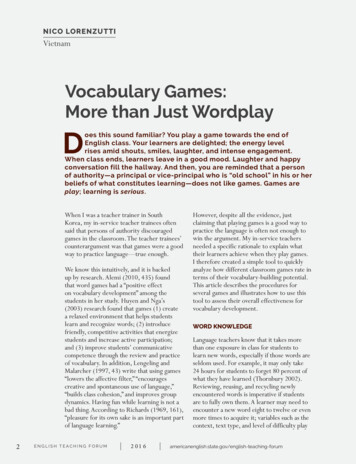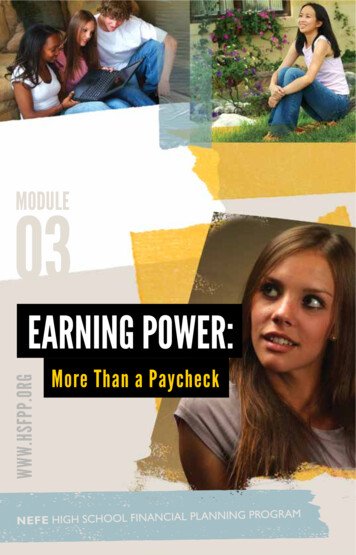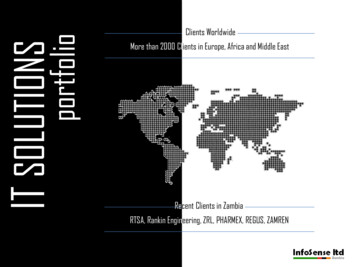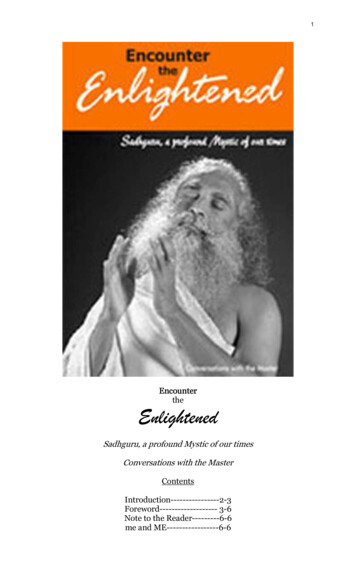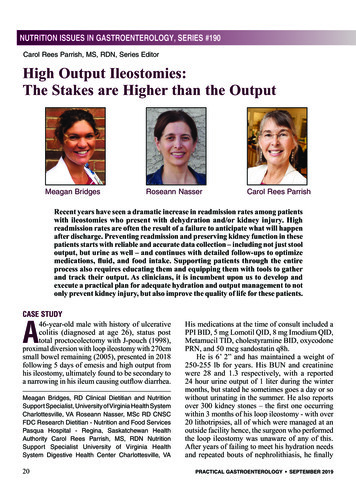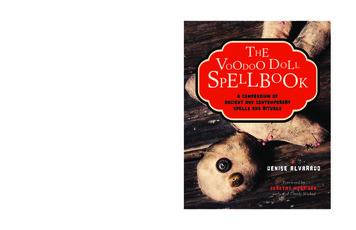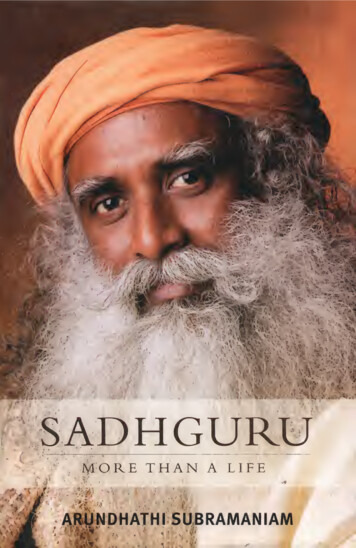
Transcription
SADHGURUMORE THAN A LIFEWt
This is the extraordinary story of Sadhguru—a young agnostic who turned yogi, a wildmotorcyclist who turned mystic, a sceptic whoturned spiritual guide. Pulsating with his razorsharp intelligence, bracing wit and modern-dayvocabulary, the book empowers you to exploreyour spiritual self and could well change your life.It seeks to re-create the life journey of a manwho combines rationality with mysticism,irreverence with compassion, ancient wisdomwith a provocatively contemporary outlook anda deep knowledge of the self with a contagiouslove of life. Described as ‘a profound mystic,visionary humanitarian and prominent spiritualleader of our times’, he is equally at home in asatsangh in rural Tamil Nadu as at the WorldEconomic Forum in Davos.In his early years, JaggiVasudev (or Sadhguruas he is now known) was a chronic truant, aboisterous prankster, and later a lover ofmotorbikes and fast cars. It is evident that thesame urgency, passion and vitality echo in hisspiritual pursuits to this day, from his creationof the historic Dhyanalinga—the mission ofthree lifetimes—to his approach as a guru.In Sadhguru s view, faith and reason, spiritualityand science, the sacred and the material, cannotbe divided into easy binaries. He sees people as‘spiritual beings dabbling with the materialrather than the reverse’, and liberation as thefundamental longing in every form of life.Truth for him is a living experience insteadof a destination, a conclusion, or a matter ofmetaphysical speculation. The possibility of selfrealization, he strongly believes, is available to all.Drawing upon extended conversations withSadhguru, interviews with Isha colleagues andfellow meditators, poet Arundhathi Subramaniampresents an evocative portrait of a contemporarymystic and guru—a man who seems to pack theintensity and adventure of several lifetimes into asingle one.
SadhguruMore Than a LifeARUNDHATHI SUBRAMANIAMANANDA
PENGUIN ANANDAPublished by the Penguin GroupPenguin Books India Pvt. Ltd, 11 Community Centre, Panchsheel Park,New Delhi 110 017, IndiaPenguin Group (USA) Inc., 375 Hudson Street, New York, New York 10014,USAPenguin Group (Canada), 90 Eglinton Avenue East, Suite 700, Toronto, Ontario,M4P 2Y3, Canada (a division of Pearson Penguin Canada Inc.)Penguin Books Ltd, 80 Strand, London WC2R 0RL, EnglandPenguin Ireland, 25 St Stephen’s Green, Dublin 2, Ireland (a division of PenguinBooks Ltd)Penguin Group (Australia), 250 Camberwell Road, Camberwell, Victoria 3124,Australia (a division of Pearson Australia Group Pty Ltd)Penguin Group (NZ), 67 Apollo Drive, Rosedale, Auckland 0632, New Zealand(a division of Pearson New Zealand Ltd)Penguin Group (South Africa) (Pty) Ltd, 24 Sturdee Avenue, Rosebank, Johannesburg2196, South AfricaPenguin Books Ltd, Registered Offices: 80 Strand, London WC2R 0RL, EnglandFirst published in Penguin Ananda by Penguin Books India 2010Copyright Arundhathi Subramaniam 2010All rights reserved10 9 8 7 6 5 4 3ISBN9780670085125Typeset in Adobe Garamond by InoSoft Systems, NoidaPrinted at Chaman Offset Printers, DelhiThis book is sold subject to the condition that it shall not, by way of trade orotherwise, be lent, resold, hired out, or otherwise circulated without the publisher’sprior written consent in any form of binding or cover other than that in which it ispublished and without a similar condition including this condition being imposedon the subsequent purchaser and without limiting the rights under copyright reservedabove, no part of this publication may be reproduced, stored in or introduced intoa retrieval system, or transmitted in any form or by any means (electronic,mechanical, photocopying, recording or otherwise), without the prior writtenpermission of both the copyright owner and the above-mentioned publisher of thisbook.
ContentsPrefaceIntroduction‘Pure Awareness and Madness’vii117The Beginning of the Journey‘Falling Upwards’24Lifetimes Three‘This One Will Graze Human Beings’30The Black Sheep Who Turned ShepherdThe Man Who ‘Went Up and Never Came Down’77From Motorcyclist to Mystic‘Compassion as Conspiracy’101Preparing for Harvest‘When the Divine Descends, You Just Accommodate’138The Deepening Pilgrimage, the Darkening Night‘If You Drop Your Fruit Willingly,Stones Can Be Minimized’Countdown, Crisis, Denouement181
viContents‘Time to Graze the Valleys of Life’205The Master, the Man and his Message‘The Ball Game’ and Beyond234The Master PlanPostscript239
PrefaceThis book is a subjective account of one man’s life journey—ormore accurately, life journeys. It is emphatically not a biography,if the word evokes expectations of an authenticated catalogue ofdates, times and events. It is based on my conversations with thesubject, with those acquainted with him, as well as on archivalmaterial from the Isha Yoga Centre in Coimbatore.When the subject happens to be a mystic, one inevitably entersthe realm of the hyper-subjective. I have relied largely on Sadhguru’sversion of events—inner and outer—in the early part of his life.Subsequently, I have relied on the views and impressions of those whohappened to be around him as his mission as a guru unfolded.I decided to implicate my own journey as a seeker in the storyprimarily as a contextual device. It also seemed only fair to givethe reader an idea of my own position (with its implicit biases andlimitations) rather than assume a bogus omniscience as storyteller. Itbecame increasingly apparent to me as the narrative progressed thatit would be impossible to play the consistent role of an impersonalthird-person narrator. As a result, I have consciously inserted myselfinto the tale at certain points, to ask my share of questions andcounter-questions that I assume several readers will share.I am grateful to all those at the Isha Yoga Centre who delved intopersonal memory and shared some of their deepest life experienceswith me. This book would not have been possible without their
viiiPrefacegenerosity, their honesty, their insight. There are as many versionsof Sadhguru as there are people who know him, and I encounteredmany simmering potential biographers on the way. This book claimsto be no more than one non-definitive version of Sadhguru’s lifeand the birth of Isha. Hopefully, there will be others.My special thanks to Maa Gnana at the Isha Archives whoattended to my many diverse requests with unflappable calm andan unwaveringly radiant smile; to Swami Chitranga and SwamiDevasatwa who helped design the cover; and to Ravi Singh andKamini Mahadevan of Penguin for the sensitivity and attentionthat they brought to the birthing of this book.I am grateful, above all, to Sadhguru for the freedom he allowedme over this manuscript, for his ability to home in on detail withoutturning micro-managerial—and for the almost terrifying elan withwhich he leaves his life ‘open, allowing readers of all persuasionsto draw their own conclusions.
IntroductionIthought gurus happened to other people. Let me confess tomy snobbery right away. I thought they happened to a certainkind of safari-suited Indian man and his docile status quoist wife.I thought they happened to those who knew the finer points ofritual red-tapism and pundit protocol, those who knew how todive at holy feet and look ecstatic at satsanghs.That’s true on one level, but a somewhat facetious level, I admit.Let me also say that as a seeker (with my own share of tormentand yearning), I had read enough to know all that stuff aboutmasters appearing when students are ready. But what are the chancesanyway of a master appearing on a peak-hour Mumbai local? Orat a poetry reading? Or a city bookshop or theatre or cafe? Andwhat are the chances of a master speaking my particular language,figuring out my convoluted inner geography—my simultaneousneed for guidance and dislike of guides, my need for a vocabularythat is sacred and yet secular? And what about my ability to turnmentors into tormentors?No, gurus didn’t happen to contemporary urban women.Psychotherapists happened to us. Books and conversations happenedto us. Wittgenstein-and-Kierkegaard-and-Krishnamurti spoutingfriends happened to us. Gurus belonged to another era, anotherworld—a simpler world where there were simpler divides betweenthe leader and the led. The only guru I could envisage was the sage
2Sadhguruin a B-grade Indian mythological movie with a candyfloss beardand an air of constipated benignity.Dead gurus were fine. They left behind words that provoked,challenged. That was a manageable bequest. But live gurus wereunthinkable. Or to put it another way, I knew I didn’t have thequalifications—social, cultural or historical—to deserve them.Existential qualifications? I thought I had some. That is, ifqualifications meant an absence. The unease, the out-of-kilterfeelings, the lwhat-does-it-all-add-up-to’ questions, the sudden fearof death ‘on dawn visits to the bathroom’—I’d been there, donethat. And while some of those clammy moments could be addressedby a poem, or love, or sex, or travel, or a book, or even chocolate,I knew there were others that couldn’t.And yogis? I thought they were a bit like unicorns. Near mythic.I thought they were to be found in remote Himalayan caves or inexotic spiritual literature (like Paramahansa Yogananda’s Autobiographyof a Yogi). The only yogis I knew of were the kind who held classestwo days a week to ‘beat stress’ and ‘combat diabetes’.Then I met Sadhguru.Many things changed in my life after that encounter six yearsago. I learnt, for one, that yogis exist. I mean, real yogis. I learntthat they aren’t mere contortionists or New Age faddists; that theyhave at their disposal a time-tested and sophisticated technology oftransformation capable of radically empowering the seeker on thepath to self-understanding.I learnt that enlightenment isn’t the sole prerogative of theBuddha or Christ or Akka Mahadevi or Ramakrishna—or any ofthose conveniently dead and buried. That it is possible to meeta man who can address the questions of life and death with thecrisp authority of an adept, but also talk with childlike enthusiasmabout a motorcycle, a Salman Rushdie novel or a game of golf. Aman who can read minds, heal, talk about past and future lives, yetremain rational, scientific, down-to-earth, devastatingly logical. Aman who can discuss karma, nirvana and ancient spiritual traditions,yet remain liberal, provocative, contemporary.
Introduction3A website describes him as ‘a self-realized yogi and profoundmystic of our times, a visionary humanitarian and prominent spiritualleader’. He is all that and more. Sadhguru is the founder of the IshaFoundation in Coimbatore, an organization with well over a hundredcentres in India and other parts of the world. Today the centresboast of millions of practitioners of Isha yoga in various parts of thecountry, the US, UK and Europe. With his razor-sharp intelligence,astringent wit, modern-day vocabulary and commitment to variedsocial causes, he is in growing demand as an international speaker.He is equally at home in a satsangh for thousands of meditatorsin India as he is at the World Economic Forum in Davos; equallyat ease with a group of Tamil peasants or prisoners as he is at theUnited Nations Millennium Peace Summit.But that’s just bio-note stuff. It conveys nothing of the manhimself. A man who is a mystic, not a metaphysician. A sage, nota scholar. A guru, not a godman. An exuberantly vibrant humanbeing, not a beaming plaster saint.This is a book about the kind of person I never expected tomeet. A person whom I consider to be a guru simply because hedoesn’t fit into any of the other categories I know. I’ve tried togive the relationship a name. Friendship comes closest. But it’snot just that either.I’m not given to easy adoration. I have long suffered from anaffliction that I term ‘insubordination’—a primal discomfort withauthority figures and gatekeepers of all kinds. And with it goes adislike of the mush and gush, the slavering superlatives and ‘lotusfeet’ rhetoric that accompanies a feudal guru-based culture. I grewup with a rationalist critique of religion, and although a love of artsoftened some of the dogmatic aspects of that rationality, I’m stilla stout champion of commonsense on many matters.Having got that out of the way, let me confess that he awes me.Not merely because he is wise, but because of how lightly he wearsthat wisdom. Not merely because he is compassionate—and hehas been profligate with his time, his attention, his energies—but
4Sadhgurubecause he gives of himself without being patronizing, without everallowing the recipient to feel diminished. Not merely because hehas presence. But because that presence spells so much more thanwhat contemporary culture eulogizes as charisma. Not because heis regarded as a master. But because his refusal to exude any senseof entitlement has actually helped banish my long-standing allergyto the term.He is quite simply the most alive human being I have met.Also the most spacious, capable of turning from robust to refined,energetic to still, earthy to subtle in a moment. That also makeshim the most remarkable person I know.Poetry matters to me. I value its language of texture and inflection.That makes me wary of many of the foot-in-the-door strategies ofadvertising. But in this case, it wouldn’t be far from the truth tosay that I can divide my life into two distinct phases: pre- and postSadhguru. Before and after. To give an idea of why I value the ‘after’,it would make sense to share something about the ‘before’.Like so many others, I’ve spent much of my life wanting toknow. And that’s meant a pretty basic quest—a search for a teacher.I don’t think I’ve asked for much either. Omniscience? No. In fact,I sensed early that those who seemed to have all the answers wereshamming. Corruption is a strong word, but my earliest experienceof it was among teachers. Several teachers I knew in school anduniversity—and t
In Sadhguru s view, faith and reason, spirituality and science, the sacred and the material, cannot be divided into easy binaries. He sees people as ‘spiritual beings dabbling with the material rather than the reverse’, and liberation as the fundamental longing in every form of life. Truth for him is a living experience instead of a destination, a conclusion, or a matter of metaphysical .

